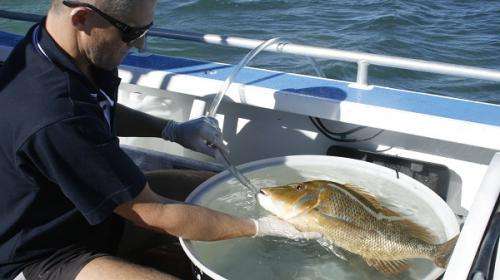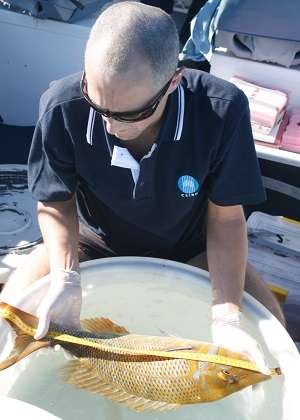Ningaloo snapper branches out of sanctuary zone

Spangled emperor (Lethrinus nebulosus) within the Ningaloo Marine Park have been found to move outside the sanctuary's boundary a year after being tagged—presenting possible implications for shoreline fishing rules.
The CSIRO and Western Australia Marine Science Institute (WAMSI) study used Australia's largest array of acoustic listening stations to gain a better understanding of the spangled emperor's movement patterns, particularly in relation to marine protected areas.
They tagged 84 spangled emperor and monitored their movement and place of residence for more than two and a half years.
Lead author Dr Richard Pillans says spangled emperor are one of the most recreationally fished species within the Ningaloo Marine Park.
"The fact we were able to tag so many fish ranging in size from juveniles to adults (26–67cm) and monitor their movement within an area of 28km² for such a long time meant we had an insight into what the population as a whole was doing, rather than just a few individuals," he says.
"This research showed that, although half the fish tagged displayed limited movements around the area they were tagged in, one year after being tagged more than 60 per cent had moved outside the sanctuary zone boundary and also outside the 28km² area that was being monitored.
"So although the home range of individual fish was, on average, three to five times smaller than the average size of sanctuary zones, more than half of the fish we monitored didn't stay in the same place for long periods.

"The next question we have to address is where these fish moved to and since we have expanded the size of our array of receivers we are now in a better position to answer this question."
CSIRO Oceans and Atmosphere is now working closely with marine park managers to ensure the study findings are used in the adaptive management of Ningaloo Marine Park so the size, shape and configuration of sanctuary zones can meet their objectives.
"Many of the fish monitored as part of the study spent large amounts of time close to the shoreline, increasing their susceptibility to capture by shore-based fishing," Dr Pillans says.
"These results are interesting in light of findings of recent CSIRO modelling which included an assessment of changing shoreline fishing rules in an examination of potential management strategies for spangled emperor in Ningaloo Marine Park."
Provided by Science Network WA















